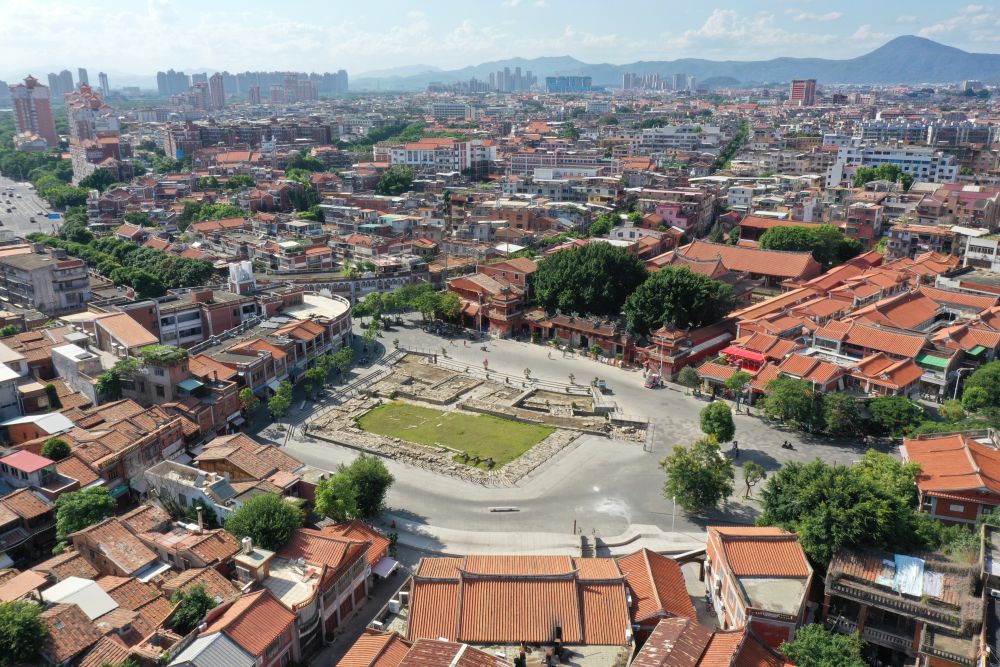The Ancient Oriental Port Quanzhou Admired by Marco Polo inscribed on the World Heritage List
2021-07-25 23:25:29
By Reporters Li Huiying, Tai Xiao’an and Zhang Yizhi Fuzhou, July 25 (Xinhua News Agency) Quanzhou, the grand oriental port, which amazed the Italian traveler Marco Polo more than 700 years ago, became China’s 56th World Heritage Site on July 25, 2021.
On July 25, 2021, the cultural heritage nomination "Quanzhou: Emporium of the World in Song-Yuan China" was successfully inscribed on the UNESCO World Heritage List at the extended 44th session of the World Heritage Committee held in Fuzhou.

This is the Site of Deji Gate and the surrounding urban landscape of Quanzhou (photo taken by a drone on July 7, 2021). Photo by Xinhua News Agency reporter Jiang Kehong
The session indicated that the nomination includes 22 representative historical sites along the coast and inland and their associated environments and spaces, reflecting the key factors for Quanzhou to become the world's marine business center from the 10th to the 14th centuries and testifying to the integrity and authenticity of the nomination .
Located in Fujian Province on the southeast coast of China, the city of Quanzhou has a history of more than 1,300 years. Marco Polo said in his travel notes that "Zayton (Quanzhou) is one of the largest ports in the world. A large number of merchants gather here and goods are piled up like mountains."
The historical sites of "Quanzhou: Emporium of the World in Song-Yuan China" can be divided into administrative institutions and structures such as the Site of Maritime Trade Office, Kaiyuan Temple and other multi-community religious buildings and statues, Quanzhou Confucian Temple and School and other cultural and historical memorial sites, ceramics and iron production bases such as the Sites of Dehua Kilns, as well as a water and land transportation network consisting of bridges, docks, and navigation towers.

This is the Liusheng Pagoda in Shishi City, Quanzhou (photo taken by a drone on July 7, 2021). Photo by Xinhua News Agency reporter Song Weiwei
The ancient Quanzhou city took the urban area of the Jiangkou Plain as its center of operation, the vast sea area to the southeast as its gateway to the outside world, and the mountainous area to the northwest as its industrial base. The interconnected water and land transportation network and the interlinked development of the port, the city, and the hinterland made it possible for ancient Quanzhou to become the maritime hub of the trade network in East Asia and Southeast Asia.
The 10th to 14th centuries were the maritime period of Asia, and witnessed the emergence of the "first world (trade) system". As the business center of this system, Quanzhou maintained trade relationships with more than one hundred countries.
Quanzhou in Song-Yuan China was not only the world's maritime trade center but also served as a window for dialogue between China and the world's civilizations.

The Chinese delegation watches the review process of the nomination "Quanzhou: Emporium of the World in Song-Yuan China" online at the extended 44th session of the World Heritage Committee in Fuzhou on July 25, 2021. Photo by Xinhua News Agency reporter Jiang Kehong
Businessmen, travelers, and missionaries from various countries came to Quanzhou via the Maritime Silk Road, and their descendants still live here today. Foreign cultures from ancient Persia, Arab countries, India, and Southeast Asia have blended with the Chinese culture in Quanzhou to generate the city's diverse, open and inclusive characteristics that continue to this day.
"The spirit carried by Quanzhou in Song-Yuan China is in the same line as the idea of joint contribution, shared benefits, and win-win cooperation with the 'Belt and Road' Initiative. The heritage left by ancient Quanzhou to the world shows that China's promotion of building a community with a shared future for mankind is by no means utopian and is completely achievable," said Li Guohong, an expert on overseas transportation history.